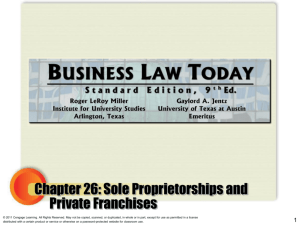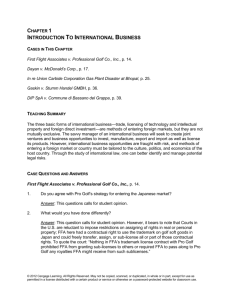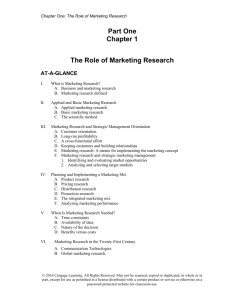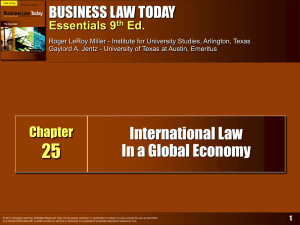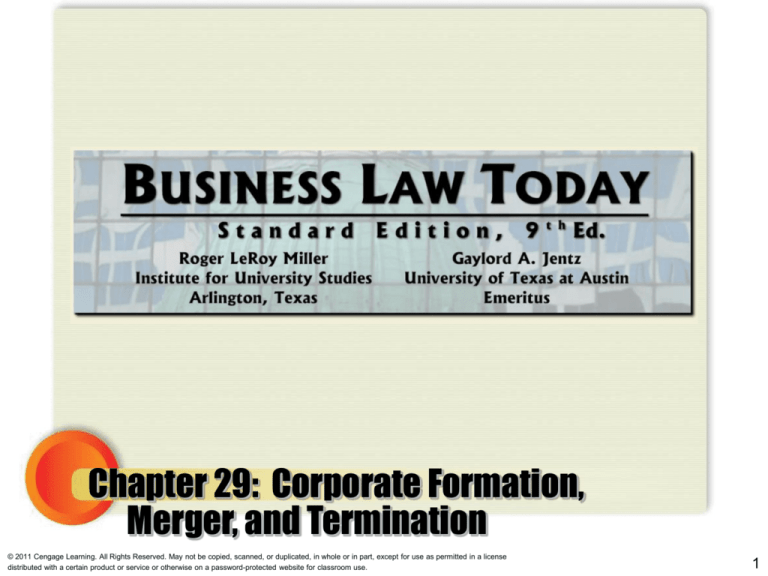
Chapter 29: Corporate Formation,
Merger, and Termination
© 2011 Cengage Learning. All Rights Reserved. May not be copied, scanned, or duplicated, in whole or in part, except for use as permitted in a license
distributed with a certain product or service or otherwise on a password-protected website for classroom use.
1
Learning Objectives
• What steps are involved in bringing a
corporation into existence?
• What is the difference between a de jure
and a de facto corporation?
• In what circumstances might a court
disregard the corporate entity (“pierce the
veil”) and hold shareholders personally
liable?
• What are the basic differences between a
merger, a consolidation, and a share
exchange?
• What are the two ways in which a
corporation can be voluntarily dissolved?
© 2011 Cengage Learning. All Rights Reserved. May not be copied, scanned, or duplicated, in whole or in part, except for use as permitted in
a license distributed with a certain product or service or otherwise on a password-protected website for classroom use.
2
The Nature of the Corporation
• A corporation is a legal entity, a
creature of statute, an artificial
“person.”
– Most states follow the Model Business
Corporation Act (MBCA) or the RMBCA, that
are model corporation laws.
• The shares (stock) of a corporation are
owned by at least one shareholder
(stockholder).
© 2011 Cengage Learning. All Rights Reserved. May not be copied, scanned, or duplicated, in whole or in part, except for use as permitted in
a license distributed with a certain product or service or otherwise on a password-protected website for classroom use.
3
Corporate Personnel
• Board of Directors: manage the big
picture, set policy, hire officers.
• Officers: manage the day-to-day
operations of the corporation.
© 2011 Cengage Learning. All Rights Reserved. May not be copied, scanned, or duplicated, in whole or in part, except for use as permitted in
a license distributed with a certain product or service or otherwise on a password-protected website for classroom use.
4
Constitutional Rights of Corporations
• A corporation is an artificial “person”
and has constitutional rights to:
– Equal protection;
– Access to the courts, can sue and be sued;
– Right to due process before denial of life,
liability or property.
© 2011 Cengage Learning. All Rights Reserved. May not be copied, scanned, or duplicated, in whole or in part, except for use as permitted in
a license distributed with a certain product or service or otherwise on a password-protected website for classroom use.
5
Constitutional Rights of Corporations
• Corporation’s rights (cont’d):
– Freedom from unreasonable search and
seizure and double jeopardy.
– Freedom of speech.
• Only officers and directors have protection
against self-incrimination.
– However, corporations do not have full
protection of privileges and immunities
clause.
© 2011 Cengage Learning. All Rights Reserved. May not be copied, scanned, or duplicated, in whole or in part, except for use as permitted in
a license distributed with a certain product or service or otherwise on a password-protected website for classroom use.
6
Limited Liability of Shareholders
• The corporation provides limited
liability for stockholders.
• In certain situations, the corporate
“veil” of limited liability can be
pierced, holding the shareholders
personally liable.
© 2011 Cengage Learning. All Rights Reserved. May not be copied, scanned, or duplicated, in whole or in part, except for use as permitted in
a license distributed with a certain product or service or otherwise on a password-protected website for classroom use.
7
Corporate Earnings and Taxation
• Corporate profits can either be kept as
retained earnings or passed on to the
shareholders as dividends.
• Corporate profits are taxed under federal
and state law as a separate “person” from
its shareholders.
• Taxation: Regular “C” corporations are
taxed twice: at the corporate level and at the
shareholder level.
• Holding Companies: used to defer U.S.
income taxes (hold shares of another).
© 2011 Cengage Learning. All Rights Reserved. May not be copied, scanned, or duplicated, in whole or in part, except for use as permitted in
a license distributed with a certain product or service or otherwise on a password-protected website for classroom use.
8
Torts and Criminal Acts
• A corporation is liable for the torts
committed by its agents or officers
within the course and scope of their
employment under the doctrine of
respondeat superior.
• Corporation can be liable for criminal
acts, but only fined. Responsible
officers may go to prison.
© 2011 Cengage Learning. All Rights Reserved. May not be copied, scanned, or duplicated, in whole or in part, except for use as permitted in
a license distributed with a certain product or service or otherwise on a password-protected website for classroom use.
9
Classification of Corporations
• Domestic corporation does business
in its state of incorporation.
• Foreign corporation from X state doing
business in Z state.
• Alien Corporation: formed in another
country doing business in United
States.
© 2011 Cengage Learning. All Rights Reserved. May not be copied, scanned, or duplicated, in whole or in part, except for use as permitted in
a license distributed with a certain product or service or otherwise on a password-protected website for classroom use.
10
Classification of Corporations
• Public and Private.
• Nonprofit.
• Close Corporations.
– Shares held by family members or very few
shareholders. Management is information, similar to a
partnership.
– Transfer of shares is restricted.
– Misappropriation of Funds is a major issue.
Case 29.1 Williams v. Stanford.
Two minority shareholders prevented one 70%
shareholder from transferring of corporate assets after
proving abuse and fraud.
© 2011 Cengage Learning. All Rights Reserved. May not be copied, scanned, or duplicated, in whole or in part, except for use as permitted in
a license distributed with a certain product or service or otherwise on a password-protected website for classroom use.
11
Classification of Corporations
• “S Corporations”: Avoids the federal
“double taxation” of regular corporations at
the corporate level. Only dividends are taxed
to the shareholders as personal income. IRS
requirements:
– Corporation is domestic, fewer than 75 shareholders,
only one class of stock, no shareholder can be a nonresident alien.
• Professional Corporations.
© 2011 Cengage Learning. All Rights Reserved. May not be copied, scanned, or duplicated, in whole or in part, except for use as permitted in
a license distributed with a certain product or service or otherwise on a password-protected website for classroom use.
12
Corporate Formation and Powers
• The process of incorporation
generally involves two steps:
– Promotional Activities; and
– The Legal Process of Incorporation.
© 2011 Cengage Learning. All Rights Reserved. May not be copied, scanned, or duplicated, in whole or in part, except for use as permitted in
a license distributed with a certain product or service or otherwise on a password-protected website for classroom use.
13
Incorporation Procedures
Promotion
File Articles of
Incorporation
Name
Search
State
Charter
© 2011 Cengage Learning. All Rights Reserved. May not be copied, scanned, or duplicated, in whole or in part, except for use as permitted in
a license distributed with a certain product or service or otherwise on a password-protected website for classroom use.
Subscribers
1st Organizational Meeting
14
Promotional Activities
• Before corporation is formed,
promoters are the persons who take the
preliminary steps of organizing the
venture and attracting subscribers
(investors) via subscription
agreements.
• A Promoter (or corporation) can create
a prospectus required by federal and
state securities laws to inform and
protect investors.
© 2011 Cengage Learning. All Rights Reserved. May not be copied, scanned, or duplicated, in whole or in part, except for use as permitted in
a license distributed with a certain product or service or otherwise on a password-protected website for classroom use.
15
Promoter’s Liabilities
• Promoter is personally liable for preincorporation contracts on behalf of the
corporation, unless 3rd party agrees to
hold future corporation liable.
• After corporate formation, corporation
can adopt the pre-incorporation
contract and release the promoter by
creating a “novation”.
© 2011 Cengage Learning. All Rights Reserved. May not be copied, scanned, or duplicated, in whole or in part, except for use as permitted in
a license distributed with a certain product or service or otherwise on a password-protected website for classroom use.
16
Incorporation Process: Articles
of Incorporation
• State Chartering: Select state (some
states such as Delaware cater to
corporations).
– Articles of Incorporation: primary enabling
document filed with the Secretary of State
that includes basic information about the
corporation.
– Person(s) who execute the articles are the
incorporators (and maybe the promoters).
© 2011 Cengage Learning. All Rights Reserved. May not be copied, scanned, or duplicated, in whole or in part, except for use as permitted in
a license distributed with a certain product or service or otherwise on a password-protected website for classroom use.
17
Preparing the Articles of Incorporation
• Choose and reserve a Corporate
Name.
• Name must have the proper suffix:
“corporation,” “corp.,” “Incorporated.”
• You should also consider registering
the corporation as a “dot com” at
networksolutions.com or
register.com.
© 2011 Cengage Learning. All Rights Reserved. May not be copied, scanned, or duplicated, in whole or in part, except for use as permitted in
a license distributed with a certain product or service or otherwise on a password-protected website for classroom use.
18
Preparing the Articles of Incorporation
• Purpose: trend towards “any legal
business.”
• Duration: usually perpetual.
• Capital Structure: Most states requires
some minimal capitalization (Texas
requires $1,000), plus number and
class(es) of shares authorized and “par
value” of shares at incorporation.
© 2011 Cengage Learning. All Rights Reserved. May not be copied, scanned, or duplicated, in whole or in part, except for use as permitted in
a license distributed with a certain product or service or otherwise on a password-protected website for classroom use.
19
Preparing the Articles of Incorporation
• Internal Organization: usually included
in the bylaws.
• Registered Office and Agent: specific
person that will receive any legal
notice and documents from state
and/or 3rd parties.
• Incorporators (usually the promoter):
at least one with name and address.
© 2011 Cengage Learning. All Rights Reserved. May not be copied, scanned, or duplicated, in whole or in part, except for use as permitted in
a license distributed with a certain product or service or otherwise on a password-protected website for classroom use.
20
First Organizational Meeting
• After the corporation is “chartered”
(created) it and can do business.
• Shareholders should have the first
organizational meeting to: approve the
bylaws, elect directors, hire officers
and adopt pre-incorporation contracts
and activities.
© 2011 Cengage Learning. All Rights Reserved. May not be copied, scanned, or duplicated, in whole or in part, except for use as permitted in
a license distributed with a certain product or service or otherwise on a password-protected website for classroom use.
21
Corporate Powers
• The express powers of a corporation
are found in the corporation’s articles
of incorporation, the laws of the state
of incorporation, and in the state and
federal corporations.
• Corporate by-laws may also grant or
limit a corporation’s express powers.
© 2011 Cengage Learning. All Rights Reserved. May not be copied, scanned, or duplicated, in whole or in part, except for use as permitted in
a license distributed with a certain product or service or otherwise on a password-protected website for classroom use.
22
Corporate Powers
• Corporation has implied powers to: to
perform all acts reasonably necessary
to accomplish its corporate purposes,
e.g.,:
• Borrow and lend money.
• Extend credit.
• Make charitable contributions.
– A corporate officer can bind corporation in
contract in matters connected with the
ordinary business affairs of the enterprise.
© 2011 Cengage Learning. All Rights Reserved. May not be copied, scanned, or duplicated, in whole or in part, except for use as permitted in
a license distributed with a certain product or service or otherwise on a password-protected website for classroom use.
23
Ultra Vires Doctrine
• Corporate acts are beyond the express
or implied powers of the corporation as
stated in state statute or the
corporation’s own articles of
incorporations and are considered to
be “ultra vires” (beyond the powers).
• Corporate articles of incorporations
now adopt very broad purposes to
prevent lawsuits against the
corporation.
© 2011 Cengage Learning. All Rights Reserved. May not be copied, scanned, or duplicated, in whole or in part, except for use as permitted in
a license distributed with a certain product or service or otherwise on a password-protected website for classroom use.
24
Ultra Vires Doctrine
• The following remedies are available for
ultra vires acts:
– Shareholders can bring action for
corporation.
– Corporation can recover damages from
its officers and directors.
– Attorney general of state may bring
action to dissolve corporation for ultra
vires acts.
© 2011 Cengage Learning. All Rights Reserved. May not be copied, scanned, or duplicated, in whole or in part, except for use as permitted in
a license distributed with a certain product or service or otherwise on a password-protected website for classroom use.
25
Defects in Formation and Corporate Status
• Errors in incorporation procedures
when a 3rd party seeks to bring an
action against a corporation that may
not have complied perfectly with every
incorporation law.
• Problematic for shareholders who may
be personally liable.
• In addition, entity may not be able to
enforce contracts.
© 2011 Cengage Learning. All Rights Reserved. May not be copied, scanned, or duplicated, in whole or in part, except for use as permitted in
a license distributed with a certain product or service or otherwise on a password-protected website for classroom use.
26
Corporate Status
• De Jure Corporation: substantial statutory
requirements are met; cannot be attacked
by state or 3rd parties.
• De Facto Corporation: statutory
requirements not met, but promoters made
good faith effort to comply with corporate
law;corporate status can only be attacked by
state.
• Corporation By Estoppel: if it acts like a
corporation, cannot avoid liability by
claiming that no corporation exists.
© 2011 Cengage Learning. All Rights Reserved. May not be copied, scanned, or duplicated, in whole or in part, except for use as permitted in
a license distributed with a certain product or service or otherwise on a password-protected website for classroom use.
27
Corporate Status
• Corporation By Estoppel: if it acts like
a corporation, cannot avoid liability by
claiming that no corporation exists.
Case 29.2 Brown v. W.P. Media, Inc.
Firm that represented itself as a corporate entity is
estopped from denying liability for breach of contract
even if it was did not exist at the time of the contract.
© 2011 Cengage Learning. All Rights Reserved. May not be copied, scanned, or duplicated, in whole or in part, except for use as permitted in
a license distributed with a certain product or service or otherwise on a password-protected website for classroom use.
28
Piercing the Corporate Veil
• “Piercing the Corporate Veil” occurs when
a court, in the interest of justice or
fairness,” holds shareholders personally
liable for corporate acts.
• Court concludes that shareholders used
corporation as a “shield” from illegal
activity.
• Factors a court considers:
– 3rd party tricked into dealing with a
corporation rather than the individual.
© 2011 Cengage Learning. All Rights Reserved. May not be copied, scanned, or duplicated, in whole or in part, except for use as permitted in
a license distributed with a certain product or service or otherwise on a password-protected website for classroom use.
29
Issues: Piercing the Corporate Veil
• Was corporation set up to not make a profit,
remain insolvent, or be under capitalized?
• Were statutory formalities followed?
• Was the corporation an “alter ego” of a majority
shareholder, with personal and corporate interests
commingled such that the corporation has no
separate identity?
Case 29.3 In re Aqua Clear Technologies, Inc.
Court held Discount Water was the “alter ego” of the
debtor, ACTI, and Jacobson's had created Discount
Water to solely to defraud ACTI’s creditors.
© 2011 Cengage Learning. All Rights Reserved. May not be copied, scanned, or duplicated, in whole or in part, except for use as permitted in
a license distributed with a certain product or service or otherwise on a password-protected website for classroom use.
30
Corporate Financing
Bonds
vs.
Stocks
Debt
Ownership/equity
Fixed ROI
Dividends (variable)
No votes
Vote for Management
Optional
Required
Priority over stock
Paid last
© 2011 Cengage Learning. All Rights Reserved. May not be copied, scanned, or duplicated, in whole or in part, except for use as permitted in
a license distributed with a certain product or service or otherwise on a password-protected website for classroom use.
31
Bonds
Type
Definition
Debentures
No specific corporate assets are pledged as
collateral. Backed by corporation’s general
credit rating.
Mortgages
Pledge specific real estate. If corporation
defaults, bondholders can foreclose.
Convertible
Conditions trigger bonds to convert to
corporate stock.
Callable
Can be “called in” by principal and repaid
according to bond conditions.
© 2011 Cengage Learning. All Rights Reserved. May not be copied, scanned, or duplicated, in whole or in part, except for use as permitted in
a license distributed with a certain product or service or otherwise on a password-protected website for classroom use.
32
Stocks
• Common Stock: represents true
ownership of a corporation. Provides prorata (proportional) ownership interest
reflected in control, earnings and assets.
• Preferred Stock: has preferences over
common stock.
– Cumulative Preferred.
– Participating Preferred.
– Convertible Preferred.
– Redeemable or Callable Preferred.
© 2011 Cengage Learning. All Rights Reserved. May not be copied, scanned, or duplicated, in whole or in part, except for use as permitted in
a license distributed with a certain product or service or otherwise on a password-protected website for classroom use.
33
Venture Capital and Private Equity Capital
• Venture Capital: start-up businesses
and high-risk enterprises need start-up
and expansion capital. The start-up
typically gives a share of its stock.
• Private Equity Capital: obtain capital
from wealthy investors. Ultimately, the
company may sell shares in an IPO.
• Locating potential investors online.
© 2011 Cengage Learning. All Rights Reserved. May not be copied, scanned, or duplicated, in whole or in part, except for use as permitted in
a license distributed with a certain product or service or otherwise on a password-protected website for classroom use.
34
Merger and Consolidation
• Corporations can grow and expand by:
– Mergers.
– Consolidation.
– Purchase of another corporation’s assets.
– Purchases of a controlling interest in another
corporation.
© 2011 Cengage Learning. All Rights Reserved. May not be copied, scanned, or duplicated, in whole or in part, except for use as permitted in
a license distributed with a certain product or service or otherwise on a password-protected website for classroom use.
35
Merger
• Legal combination of two
or more corporations (A &
B) after which only A
corporation remains. A’s
articles of incorporation are
amended to include articles
of merger.
• After merger, A continues
as the surviving
corporation with all of B’s
rights and obligations.
© 2011 Cengage Learning. All Rights Reserved. May not be copied, scanned, or duplicated, in whole or in part, except for use as permitted in
a license distributed with a certain product or service or otherwise on a password-protected website for classroom use.
A
B
A
36
Consolidation
• Occurs when two or more
corporations (A & B)
combine such that both
cease to exist and a new
corporation emerges which
has all the rights and
obligations previously held
by A and B.
• C’s articles of
consolidation take the
place of the original
articles of A and B.
© 2011 Cengage Learning. All Rights Reserved. May not be copied, scanned, or duplicated, in whole or in part, except for use as permitted in
a license distributed with a certain product or service or otherwise on a password-protected website for classroom use.
A
B
C
37
Share Exchange
• Some or all of the shares of one
corporation are exchanged for some or all
of the shares of another corporation, but
both corporations continue to exist.
• Share exchanges are often used to
create holding companies.
© 2011 Cengage Learning. All Rights Reserved. May not be copied, scanned, or duplicated, in whole or in part, except for use as permitted in
a license distributed with a certain product or service or otherwise on a password-protected website for classroom use.
38
Merger, Consolidation and Share Exchange
Procedures
• Board of directors of each corporation
involved must approve the merger
plan.
• Next shareholder approval of each
corporation.
• Then, articles filed with Secretary of
State and who issues a certificate of
merger to the surviving corporation or
a certificate of consolidation to the
newly consolidated corporation.
© 2011 Cengage Learning. All Rights Reserved. May not be copied, scanned, or duplicated, in whole or in part, except for use as permitted in
a license distributed with a certain product or service or otherwise on a password-protected website for classroom use.
39
Merger, Consolidation and Share Exchange
Procedures
• When allowed by state statute, a
shareholder has the right to dissent
and be bought out” of his/her shares
(shareholder’s appraisal right).
• In cases of: merger, consolidation,
purchase of assets not in the ordinary
course of business, adverse
amendments to the articles of
incorporation.
• Short-Form Mergers.
© 2011 Cengage Learning. All Rights Reserved. May not be copied, scanned, or duplicated, in whole or in part, except for use as permitted in
a license distributed with a certain product or service or otherwise on a password-protected website for classroom use.
40
Appraisal Rights
• Appraisal Rights.
– Make written offer to purchase a
dissenting shareholder’s stock,
accompanied by current balance sheet
and income statement for the
corporation.
© 2011 Cengage Learning. All Rights Reserved. May not be copied, scanned, or duplicated, in whole or in part, except for use as permitted in
a license distributed with a certain product or service or otherwise on a password-protected website for classroom use.
41
Purchase of Assets
• Sale of Corporate Assets.
– Occurs when a corporation acquires all or
substantially all of the assets of another
corporation by direct purchase.
– The purchasing, or acquiring corporation
simply extends its ownership and control
over more assets.
– Shareholder approval is not required
because there is no change in the legal
entity.
© 2011 Cengage Learning. All Rights Reserved. May not be copied, scanned, or duplicated, in whole or in part, except for use as permitted in
a license distributed with a certain product or service or otherwise on a password-protected website for classroom use.
42
Potential Liability in Purchases of Assets
• General rule: a corporation that purchases the
assets of another corporation is not
automatically responsible for the liabilities of the
selling corporation.
© 2011 Cengage Learning. All Rights Reserved. May not be copied, scanned, or duplicated, in whole or in part, except for use as permitted in
a license distributed with a certain product or service or otherwise on a password-protected website for classroom use.
43
Potential Liability in Purchases of Assets
• Exceptions to the rule are:
– 1 . When purchasing corporation assumes the seller’s
liabilities.
– 2 . When transaction is actually a merger or
consolidation.
– 3. When purchasing corporation is a continuation of
the selling corporation (same operations and
personnel).
– 4. When sale is entered into fraudulently for the
purpose of escaping liability.
• In any of these situations, the acquiring
corporation will be held to have assumed both
the assets and the liabilities of the selling
corporation.
© 2011 Cengage Learning. All Rights Reserved. May not be copied, scanned, or duplicated, in whole or in part, except for use as permitted in
a license distributed with a certain product or service or otherwise on a password-protected website for classroom use.
44
Purchase of Stock and Tender Offers
• Alternative to merger or consolidation is
the purchase of a controlling interest
(e.g., 51%) of a “target” corporation’s
stock (called a “takeover”) giving the
purchaser corporation controlling interest
in the target.
• The aggressor deals entirely with the
target’s shareholders.
– Proxy Fight, Leveraged Buyout.
© 2011 Cengage Learning. All Rights Reserved. May not be copied, scanned, or duplicated, in whole or in part, except for use as permitted in
a license distributed with a certain product or service or otherwise on a password-protected website for classroom use.
45
Purchase of Stock and Tender Offers
• Tender Offers.
– A publicly advertised offer addressed to all
shareholders of the target is called a tender
offer.
– Tender offer is usually higher than market
value per share but conditioned on the
acquisition of a certain % of shares.
• Can be in exchange for aggressor's stock.
• Sec strictly regulates tender offers.
© 2011 Cengage Learning. All Rights Reserved. May not be copied, scanned, or duplicated, in whole or in part, except for use as permitted in
a license distributed with a certain product or service or otherwise on a password-protected website for classroom use.
46
Responses to Tender Offers: Defenses
© 2011 Cengage Learning. All Rights Reserved. May not be copied, scanned, or duplicated, in whole or in part, except for use as permitted in
a license distributed with a certain product or service or otherwise on a password-protected website for classroom use.
47
Termination
• Termination of a corporation, like a
partnership, consists of two phases:
– Dissolution (voluntary or involuntary); and
– Liquidation.
• Dissolution can brought about by:
–
–
–
–
–
Act of legislature.
Certificate expiration.
Voluntary approval by shareholders and board.
Unanimous action by all shareholders.
Court order.
© 2011 Cengage Learning. All Rights Reserved. May not be copied, scanned, or duplicated, in whole or in part, except for use as permitted in
a license distributed with a certain product or service or otherwise on a password-protected website for classroom use.
48
Voluntary Dissolution
• Shareholders can initiate dissolution
by a unanimous vote to dissolve.
• Or, the Board can initiate by
submitting a proposal to the
shareholders for a vote at the annual
shareholder meeting or speciallycalled meeting.
© 2011 Cengage Learning. All Rights Reserved. May not be copied, scanned, or duplicated, in whole or in part, except for use as permitted in
a license distributed with a certain product or service or otherwise on a password-protected website for classroom use.
49
Involuntary Dissolution
• Secretary of State or Attorney
General can dissolve if Corporation:
–
–
–
–
–
–
–
–
Fails to pay taxes.
Fails to file annual report.
Fails to designate registered agent for service.
Secured its charter through fraud.
Abused its corporate power.
Violated criminal laws.
Failed to commence business operations.
Abandoned operations before start-up.
© 2011 Cengage Learning. All Rights Reserved. May not be copied, scanned, or duplicated, in whole or in part, except for use as permitted in
a license distributed with a certain product or service or otherwise on a password-protected website for classroom use.
50
Involuntary Dissolution
• Close corporations:
– May be able to be dissolved by one
shareholder on the happening of a certain
event.
– Gives the same power to a shareholder to
dissolve as a partner has for a partnership.
© 2011 Cengage Learning. All Rights Reserved. May not be copied, scanned, or duplicated, in whole or in part, except for use as permitted in
a license distributed with a certain product or service or otherwise on a password-protected website for classroom use.
51
Involuntary Dissolution
• Court can dissolve a corporation if:
– Board is deadlocked and irreparable damage
to corporation will ensue.
– Mismanagement.
– Minority shareholder is “frozen out” or
oppressed.
© 2011 Cengage Learning. All Rights Reserved. May not be copied, scanned, or duplicated, in whole or in part, except for use as permitted in
a license distributed with a certain product or service or otherwise on a password-protected website for classroom use.
52
Termination and Winding Up
• Board liquidates and acts as trustees
of assets. Court will appoint a receiver
if:
– Board refuses; or
– Creditors want a receiver.
• Winding Up.
– Directors act as trustees of corporate assets,
and personally liable.
– Courts may also appoint a receiver to wind up
the corporate affairs.
© 2011 Cengage Learning. All Rights Reserved. May not be copied, scanned, or duplicated, in whole or in part, except for use as permitted in
a license distributed with a certain product or service or otherwise on a password-protected website for classroom use.
53





